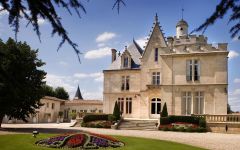Chateau Pape Clement 6-Pack OWC 2019
-
Jeb
Dunnuck -
Robert
Parker -
James
Suckling - Decanter




Product Details
Your Rating
Somm Note
Winemaker Notes
Blend: 55% Cabernet Sauvignon, 40% Merlot, 3% Cabernet Franc
The Barrel Sample for this wine is 14% ABV.
Professional Ratings
-
Jeb Dunnuck
I loved the 2019 Château Pape Clement. This beautiful terroir in the heart of Pessac has produced and magical 2019. Stunning notes of crème de cassis, spring flowers, violets, crushed stone, and lead pencil and flow to a full-bodied, flawlessly balanced, elegant effort with great tannins and a rock star of a finish. It's a rich, powerful wine, yet it's the level of purity and elegance that sets it apart. Bravo! Tasted twice.
Barrel Sample: 96-99 -
Robert Parker's Wine Advocate
Composed of 50% Cabernet Sauvignon and 50% Merlot, the 2019 Pape Clement was harvested from the 18th of September to the 11th of October. Ninety-three percent is aging in French oak barriques, 66% new, and 7% is aging in large foudres. Deep garnet-purple in color, it hits the ground running with bold, expressive notes of warm cassis, boysenberries and black cherries with an undercurrent of clove oil, fertile loam, cedar chest and tar. Medium to full-bodied, the palate offers a rock-solid foundation of firm, ripe grainy tannins and tons of freshness supporting the densely packed black fruit and earthy layers, finishing very long and mineral laced.
Barrel Score: (96-98)+
-
James Suckling
Crushed-stone and berry aromas with some blackberry and black-tea character. Just a touch of smokiness. Sweet fruit, too. This is so refined, subtle, and beautiful for Pape with full body, ultra-fine tannins and a succulent finish. The center-palate is dense and complete. Goes on for minutes. So subtle and refined, focused and classy.
-
Decanter
Continuing the strong performance of Pape Clement over recent vintages. Violet edging around the glass, and a supple tannic hold that both constricts and expands the fruit through the palate, giving a sense of momentum. There is a firm tannic grip, given drama by notes of black pepper and bitter chocolate, and a slate textured finish to slow things down and hold the flavour. Malolactic fermentation in barrels (60%) new, and ageing in both barrels (90%) and larger oak casks. Petit Verdot and Cabernet Franc are planted in the vineyard, but not yet in the 1st wine. Certified bee-friendly. Tasted twice, two weeks apart, excellent both times.
Barrel Sample: 95
Other Vintages
2021-
James
Suckling -
Robert
Parker - Decanter
-
Jeb
Dunnuck
-
Wine
Spectator -
Robert
Parker -
James
Suckling -
Jeb
Dunnuck -
Wine
Enthusiast - Decanter



Chateau Pape Clément owes its name to its most illustrious owner. A man of the cloth born in 1264, Bertrand de Goth became Bishop of Comminges, in the Pyrenees Mountains, at the age of 31; he later became Archbishop of Bordeaux in 1299.
He then received as a gift the property in Pessac, the Vineyard de La Mothe. Taken by a passion for the vine, he continually took part personally in equipping, organizing and managing the domain in accordance with the most modern and rational practices. Nevertheless, on 5 June 1305 the cardinals met in a conclave in Pérouse and appointed him to succeed Pope Benedict XI, who had passed away prematurely after only eleven months of reign. Bertrand de Goth took the name of Clement V.
Supported by Philip IV, it was he who decided in 1309 to move the papal court to Avignon, thus breaking with Rome and its battles of influence. During this same period, the weight of his responsibilities led him to relinquish his property, giving it to the Archbishop of Bordeaux. Henceforward, the vineyard was to be known to posterity under the name of this enlightened pope.
The early period
Management under the clergy brings modernity The grateful Church perpetuated Pope Clement's work. Each archbishop in turn turned to modernity and technical progress, to the point of the wine estate becoming a model vineyard. In addition to especially early harvests, which remain one of its
special characteristics, Chateau Pape Clément is without a doubt the first vineyard in France to align vine stock to facilitate labour.
After the Revolution
At the end of the 18th century, the Archbishop of Bordeaux was dispossessed of his property. The papal vineyard became part of the public domain.
The 20th century
8 June 1937 was a dark day in the vineyard's history, when a violent hailstorm
destroyed virtually the entirety of the estate. Two years later, Paul Montagne bought
it and gradually brought it back to life. Thanks to his efforts, the vineyard returned to
its former rank and stood up to the surge in urbanization.
His descendents, Léo Montagne and Bernard Magrez, perpetuate this secular
tradition so that Chateau Pape Clément wines continue to delight the wine-lovers of today and tomorrow.

One of the world’s most classic and popular styles of red wine, Bordeaux-inspired blends have spread from their homeland in France to nearly every corner of the New World. Typically based on either Cabernet Sauvignon or Merlot and supported by Cabernet Franc, Malbec and Petit Verdot, the best of these are densely hued, fragrant, full of fruit and boast a structure that begs for cellar time. Somm Secret—Blends from Bordeaux are generally earthier compared to those from the New World, which tend to be fruit-dominant.

Recognized for its superior reds as well as whites, Pessac-Léognan on the Left Bank claims classified growths for both—making it quite unique in comparison to its neighboring Médoc properties.
Pessac’s Chateau Haut-Brion, the only first growth located outside of the Médoc, is said to have been the first to conceptualize fine red wine in Bordeaux back in the late 1600s. The estate, along with its high-esteemed neighbors, La Mission Haut-Brion, Les Carmes Haut-Brion, Pique-Caillou and Chateau Pape-Clément are today all but enveloped by the city of Bordeaux. The rest of the vineyards of Pessac-Léognan are in clearings of heavily forested area or abutting dense suburbs.
Arid sand and gravel on top of clay and limestone make the area unique and conducive to growing Sémillon and Sauvignon blanc as well as the grapes in the usual Left Bank red recipe: Cabernet Sauvignon, Merlot, Cabernet Franc and miniscule percentages of Petit Verdot and Malbec.
The best reds will show great force and finesse with inky blue and black fruit, mushroom, forest, tobacco, iodine and a smooth and intriguing texture.
Its best whites show complexity, longevity and no lack of exotic twists on citrus, tropical and stone fruit with pronounced floral and spice characteristics.
